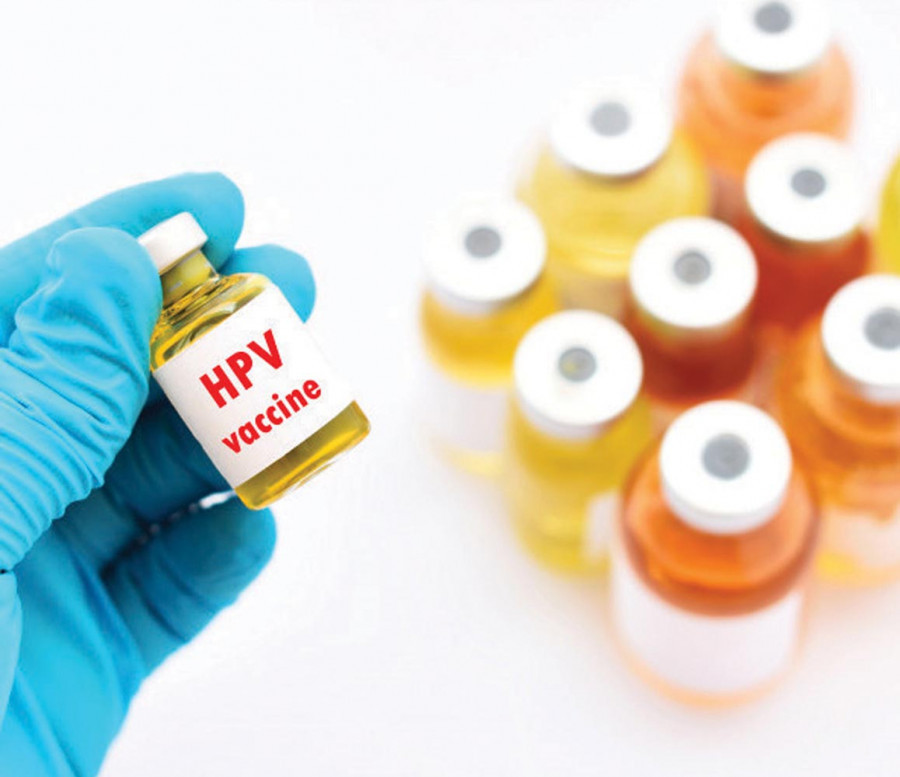Health
Girls of 11–13 age group in seven sparsely populated districts to get HPV jabs
Human papillomavirus causes cervical cancer, which is a major cause of deaths among Nepali women.
Post Report
Girls between 11 and 13 years of age living in seven sparsely populated districts, including Manang, Mustang and Ramechhap, will soon be vaccinated against the human papillomavirus (HPV). Officials at the Ministry of Health and Population said as many as 20,000 doses of the vaccine purchased by the government will arrive within the next two weeks.
“We have sent a proposal to the health ministry for consent to launch a vaccination drive in only the seven sparsely populated districts as we purchased very limited doses of the vaccine,” said Dr Abhiyan Gautam, chief of the Immunisation Section at the Family Welfare Division under the Department of Health Services. “We hope that the ministry will approve the proposal at the earliest.”
Human papillomavirus is a viral infection that spreads through skin contact. The virus causes cervical cancer, which is the second-most common cancer in the developing world and a major cause of deaths among Nepali women. It is estimated that hundreds of women get diagnosed with cervical cancer every year in Nepal.
According to the BP Koirala Memorial Cancer Hospital in Bharatpur, more than 700 women suffering from cervical cancer seek treatment at the hospital every year.
Experts say early treatment prevents up to 80 percent of cervical cancer.
The government provides free screening for cervical cancer at state-run health facilities across the country.
The World Health Organisation says HPV vaccination is recommended as part of a coordinated and comprehensive strategy to prevent cervical cancer and other diseases caused by the HPV.
In 2019, the Ministry of Health and Population had allocated Rs77.7 million—Rs 27.5 million to the Immunisation Section at Family Welfare Division under the Department of Health Services and Rs 50 million to the BP Koirala Memorial Cancer Hospital in Bharatpur—to introduce the vaccine.
The hospital purchased 12,500 doses of the vaccine spending around Rs4,000 per dose, but the government’s logistics management division failed to procure the vaccine doses on time, leading to a freezing of the budget.
More than 6,000 girls from Chitwan were inoculated with the vaccine doses.
HPV vaccination also figures in the government’s policy and programme for the fiscal year 2021-2022, but the budget was not allocated accordingly.
Officials say 20,000 vaccine doses, all set to arrive within the next two weeks, were purchased from the budget allocated for the fiscal year 2022-2023. The government plans to continue the programme in the next fiscal year as well.
Doctors say most cervical cancers are associated with the HPV, a sexually-transmitted infection. Widespread immunisation with the HPV vaccine could reduce the impact of cervical cancer and other cancers caused by the HPV worldwide.
Bhutan, Sri Lanka, Thailand and the Maldives have introduced HPV vaccines nationally, while India and Indonesia have introduced them in some districts.
In 2016, Nepal piloted an HPV vaccination drive in Chitwan and Kaski districts. All girls aged between 11 and 13 years were inoculated with two doses of the vaccine at the time.
Nepal has also requested the Global Alliance for Vaccine and Immunisation (GAVI) to provide the HPV vaccine for free so that it could be included on the regular immunisation list.
The Health Ministry had also sought help from the World Health Organisation during the Nepal visit of Director General Dr Tedros Adhanom Ghebreyesus in April last year to introduce the HPV vaccine on the regular immunisation list.
The World Health Organisation says HPV is responsible for over 70 percent of cervical cancer cases in women. Countries that have included the HPV vaccine in their regular immunisation list have successfully reduced cervical cancer cases in women, according to doctors.




 16.12°C Kathmandu
16.12°C Kathmandu













